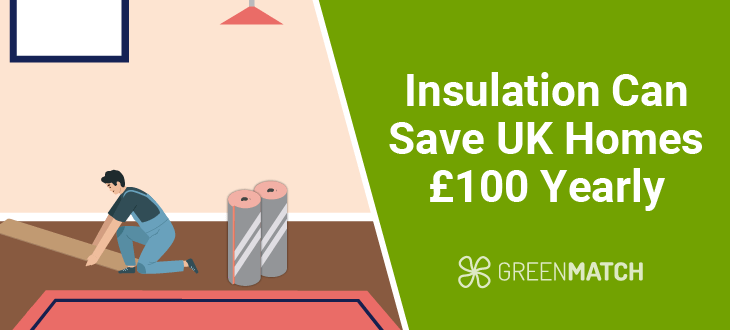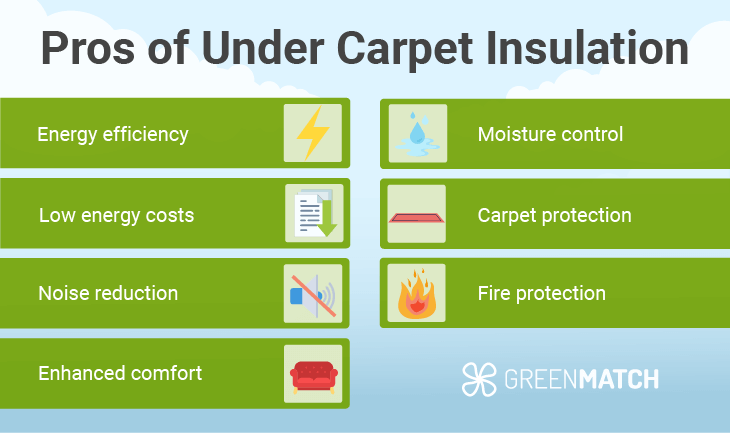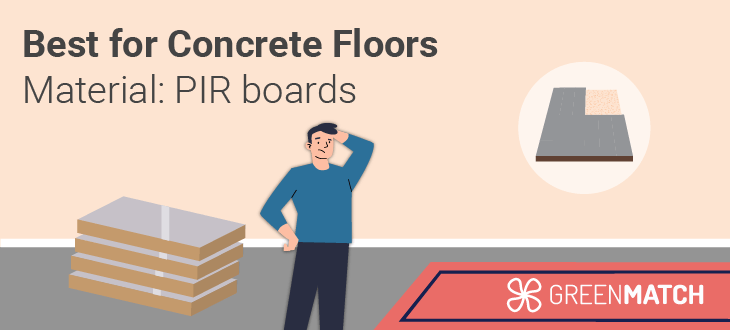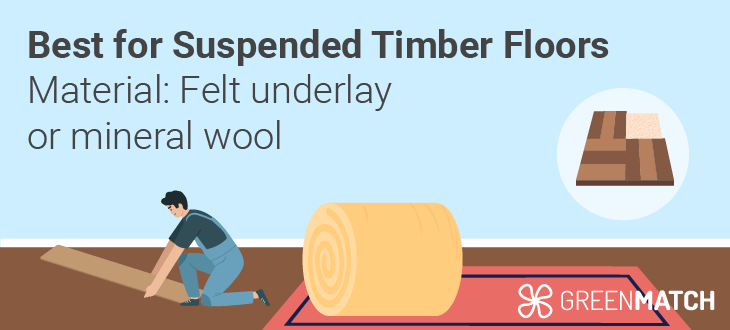Answer these simple questions and we will find you the BEST prices
Which type of solar quotes do you need?
It only takes 30 seconds
100% free with no obligation

Get Free quotes from insulation specialists near you

Save money by comparing quotes and choosing the most competitive offer

The service is 100% free and with no obligation
- GreenMatch
- Insulation
- Floor Insulation
- Under Carpet Insulation
Under Carpet Insulation: Benefits, Best Types & More


- Insulation can save UK homes an average of £60 to £100 annually, depending on the home’s size and location.
- Under carpet insulation materials cost between £5 to £20 per m².
- Insulation helps protect your carpets and floors, significantly increasing their lifespan and saving you from frequent replacements.
According to the UK’s Department for Business, Energy, and Industrial Strategy guide, properly installed floor insulation can significantly enhance thermal comfort, reduce energy bills, and contribute to reducing greenhouse gas emissions.
According to AMA Research, the UK insulation market has seen significant growth, with the value of building insulation products expected to rise to £1.5 billion by 2025. Ground-floor insulation, including under carpet, is crucial in this market expansion.
The UK market for insulation is growing, with the Energy Company Obligation (ECO) Scheme having installed millions of insulation measures in homes. This includes measures like under-slab insulation, which helps households reduce energy costs.
When deciding what is the best under carpet insulation, consider the type of floor, your insulation goals (thermal, soundproofing, or energy efficiency), and your budget. We will delve into this in the following sections.
Ready to make your home warmer and save on energy bills? Let us do the work! In just 30 seconds, you can get up to 3 free quotes from trusted installers. Click the button below to get started!
- Describe your needs
- Get free quotes
- Choose the best offer
It only takes 30 seconds



Benefits of under carpet insulation

Under carpet insulation is increasingly recognised for its benefits, from improving home comfort to enhancing energy efficiency. Whether renovating or looking for ways to boost your home's thermal performance, insulation under the carpet is a practical solution.
Improved energy efficiency
One of the most significant benefits of under carpet floor insulation in the UK is its ability to improve energy efficiency. The UK climate often demands effective heating, and homes with poor insulation lose much warmth through floors.
Insulation under carpets can reduce heat loss, making your home more energy-efficient. It helps trap warm air inside the room, reducing the need for excessive heating and lowering your energy bills. This leads to a more sustainable and cost-effective household.
Reduced energy costs
By improving your home's insulation, you’ll also see a noticeable reduction in energy costs. Insulation under carpets helps to retain heat during the winter and can even keep your home cooler in the summer.
Less reliance on heating systems leads to lower energy consumption and more manageable utility bills, which is essential given the rising energy prices in the UK.
The Energy Saving Trust estimates that insulating ground floors in UK homes can save an average of £60 to £100 per year, depending on the home’s size and location. Detached homes in Great Britain can save even more, with figures reaching £100 annually.
Noise reduction
One key advantage of under carpet insulation is its ability to reduce noise transmission between rooms. This is particularly beneficial in multi-storey homes or flats, where sound can readily travel through floors. Acoustic floor insulation, like carpet underlay, is a barrier that dampens sound, ensuring quieter spaces, which is especially important in high-traffic areas.
Enhanced comfort
Under carpet floor insulation adds an extra layer of comfort to your flooring. In addition to the softness of the carpet itself, the insulation creates a cushiony feel, making walking or standing on the surface more comfortable. This is especially valuable during colder months when hard floors can feel chilly.
Moisture control
Another advantage of carpet insulation underlay is its capacity for moisture control. Certain insulation materials can manage moisture levels, preventing dampness from accumulating under carpets.
This feature helps extend the life of your carpet and the flooring underneath, reducing the risk of mould or mildew, particularly in areas prone to high humidity.
Carpet protection
Investing in insulated underlay for carpets improves comfort and extends the life of your carpets. The insulation acts as a protective layer, absorbing wear and tear, which is especially useful in high-traffic areas. As a result, your carpets will maintain their appearance for longer, helping you avoid the cost and hassle of frequent replacements.
Fire protection
Some insulation for under-carpet materials has fire-retardant properties. This feature can provide an added layer of safety, especially in homes with children or vulnerable individuals. Although this is not the primary reason for installing insulation under rugs, it’s a valuable benefit, particularly in creating a more secure home environment.
Under carpet insulation types
Several under carpet insulation materials are available in the UK market, each offering distinct advantages and disadvantages. Here's a breakdown of standard options and their benefits, drawbacks, and price considerations.
Foam underlayment
Foam underlay is a popular, affordable choice for insulation under carpet. It is made from polyurethane foam and is available in various thicknesses to suit different insulation needs. The foam underlay typically ranges from £10 to £12 per m², making it one of the most budget-friendly options for those seeking comfort and insulation without a high investment.
- Lightweight and easy to install
- It provides decent thermal insulation
- Affordable
- Compresses over time, reducing insulation effectiveness
- Less effective for soundproofing compared to other materials
Felt underlay
Felt underlay, made from natural or recycled fibres like wool or jute, is a highly durable and eco-friendly option for carpet insulation underlay. It is especially known for its excellent thermal and soundproofing properties. The price of felt underlay is typically higher, ranging from £13 to £17.5 per m², making it a more premium choice.
- Outstanding thermal and sound insulation
- Long-lasting and retains its shape well
- Eco-friendly
- More expensive than foam underlay
- It may not offer as much cushioning as foam
Rubber underlay
Rubber underlay, available in sponge or crumb rubber, is a durable and effective solution for floor insulation under carpet, especially in high-traffic areas. Known for its superior soundproofing abilities, rubber underlay is priced between £15 and £20 per m², reflecting its high durability and performance.
- Excellent soundproofing capabilities
- Highly durable and resistant to wear and tear
- Ideal for high-traffic areas
- Moderate thermal insulation compared to felt
- It can feel harder underfoot than foam
PIR (polyisocyanurate) boards
PIR boards are a type of rigid insulation board widely used for solid floors and walls due to their high thermal efficiency. They are priced between £5 and £15 per m², offering a versatile and efficient solution for those looking to boost energy efficiency at a mid-range cost.
- Excellent thermal efficiency
- Rigid and durable
- Suitable for various applications
- Made from synthetic materials, which are less eco-friendly
- Requires professional installation in most cases
Multifoil insulation
Multifoil insulation is a high-tech solution incorporating multiple layers of reflective foil, foam, and wadding. This material is effective for thermal insulation and soundproofing but is more expensive, typically ranging from £10 to £20 per m².
- High thermal efficiency thanks to reflective properties
- It provides some sound insulation
- Versatile for various applications
- More expensive compared to traditional underlay materials
- Requires professional installation for optimal performance
What is the best under carpet insulation?
When choosing under carpet insulation, each type of flooring, whether it’s a concrete slab or suspended timber, has specific insulation needs. Here’s a breakdown of the best floor insulation and the most cost-effective and energy-efficient choices available.
Best for concrete floors

Due to their dense nature, concrete floors tend to lose a significant amount of heat, so the ideal insulation under carpet should have high thermal resistance.
PIR boards are the best choice for concrete floors. They offer excellent thermal insulation and are rigid enough to be laid directly on the concrete. Depending on the room's insulation needs, a floor insulation thickness of 25 to 50mm is recommended for optimal results.
PIR boards provide superior thermal insulation, which is ideal for colder areas like basements or ground floors. They help retain heat efficiently.
Best for suspended timber floors

Suspended timber floors, common in older UK homes, have a gap between the floor and the ground, which can lead to drafts and heat loss. Therefore, a material that can fit between the floor joists and provide both thermal and sound insulation is essential.
Felt underlay or mineral wool is considered the best for suspended timber floors. Both are durable and provide strong thermal and sound insulation. A recommended thickness of 11mm to 13mm is ideal for these materials, ensuring optimal insulation without affecting the floor height.
Felt underlay offers excellent thermal insulation and soundproofing, making it ideal for reducing noise between floors. Mineral wool is especially good for preventing drafts.
Best for energy efficiency

If your primary goal is energy efficiency, choosing an insulation material with a high R-value (a measure of thermal resistance) is crucial. Multifoil insulation is highly energy-efficient, as its multiple layers reflect heat back into the room. It is also effective in preventing heat loss, particularly in colder climates like the UK.
Multifoil is relatively thin, typically 3mm to 10mm, but its multi-layered construction compensates for the thinner material. Regarding advantages, this insulation is highly effective at reflecting radiant heat and can drastically improve the energy efficiency of a room.
Now is the perfect time to insulate your home and save on energy bills. Click the button below to get up to 3 free quotes from trusted installers and start your journey toward a warmer, more energy-efficient home today!
- Describe your needs
- Get free quotes
- Choose the best offer
It only takes 30 seconds



Best for soundproofing

Rubber underlay is often the best choice for areas where soundproofing is a priority, such as flats or multi-storey homes. Crumb rubber underlay is known for its exceptional soundproofing qualities and is ideal for high-traffic areas or places where noise reduction is important.
Soundproofing requires a thickness of approximately 10mm to 12mm. This underlayment has advantages, including significantly reducing noise transmission between floors and offering durability in high-traffic areas.
Best for price

If you're working within a tight budget, foam underlay is the most affordable option for insulation under carpet. While it may not offer the same level of performance as felt or multifoil, it’s still an effective solution for thermal insulation in moderate climates.
Foam underlay, typically made of polyurethane, is lightweight and provides decent insulation for a lower cost. A thickness of 8mm to 10mm is sufficient for most residential uses. Considering the advantages, foam underlay is easy to install and budget-friendly, making it ideal for homeowners looking for a low-cost solution.
Regarding funding options, the Great British Insulation Scheme (GBIS) is a government scheme to help people insulate their homes, make them more energy efficient and save money on their energy bills.
The government announced the scheme at the end of March 2023. The £1 billion scheme aims to help around 300,000 households nationwide with the cost of installing new home insulation and is scheduled to run until March 2026.
How to insulate under a carpet
Here’s a detailed guide on how to insulate under a carpet
- Prepare the floor: Before installing any insulation under the carpet, ensure the floor is clean, smooth, and debris-free. First, remove the existing carpet and underlay. Carefully lift the rug, especially if you plan to reuse it, and remove the underlay beneath it. Be cautious to avoid damaging the carpet. Then, clean the floor by vacuuming or sweeping to remove any dust or particles that could affect the insulation installation.
- Choose the right insulation material: The best insulation under the carpet depends on your floor type. For concrete floors, PIR boards are the most suitable option due to their high thermal resistance. For suspended timber floors, felt underlay or mineral wool is recommended for sound and heat insulation.
- Lay the insulated underlay: Once the floor is clean, roll out the insulated underlay evenly across the surface. Make sure it fits snugly and reaches the edges of the room. You may need to trim it to fit corners or around fixed furniture. Secure the underlay using double-sided tape or adhesive to prevent movement.
- Reinstall the carpet: After adequately installing the underlay, lay the carpet back over the insulation. If reusing the old carpet, ensure it’s stretched evenly across the room. If you’re using new carpet, lay it down and secure it using carpet tacks or adhesive. Finally, trim any excess material along the edges.
- Final inspection: Walk over the carpet to ensure it’s smooth and evenly laid. Check for any bumps or gaps that need adjustment, ensuring the insulation provides comfort and efficiency.
An additional tip to consider for under rug insulation is when using rugs instead of carpets, many of these materials can be adapted for insulation under a rug, improving comfort and energy efficiency even with smaller floor coverings.
Is carpet insulation a good solution for your floors?
As we established earlier, carpet insulation offers several advantages, including improved energy efficiency, greater comfort, and effective soundproofing. These benefits make it a strong option for many UK homes, especially for rooms with concrete or suspended timber floors.
The key to maximising these benefits lies in choosing the right insulation material for your specific needs. Whether you're focusing on warmth, noise reduction, or cost-efficiency, the correct insulated underlay for carpet can significantly impact performance.
For the best results, consider consulting a professional installer. Instead of spending hours searching online, let us simplify the process. We'll connect you with up to 3 free quotes from reliable, vetted installers in your area. It takes just 30 seconds to complete our quick form—click the button to get started!
- Describe your needs
- Get free quotes
- Choose the best offer
It only takes 30 seconds



FAQ
Yes, installing insulation under the carpet is a great way to improve thermal efficiency and soundproofing in your home. It helps retain heat, making rooms more comfortable and energy-efficient. Proper insulation can also reduce noise transmission between floors.
Yes, carpet underlay adds an extra layer of insulation, helping to trap heat in a room. It reduces heat loss through the floor, making the space feel warmer, especially during colder months. This also leads to energy savings as less heating is required.
Yes, insulated underlay is highly effective in both thermal insulation and soundproofing. It helps retain room heat, reduces energy costs, and provides added comfort underfoot. The effectiveness depends on the type of underlay and the flooring on which it’s installed.
To prevent moisture issues like mould or mildew, add a vapour barrier under the carpet in areas with high moisture, such as basements or ground floors. However, a vapour barrier is generally unnecessary if you’re installing carpet in a dry area.
The best under carpet insulation depends on the type of floor and your specific needs. PIR boards are ideal for concrete floors, while felt underlay is great for suspended timber floors due to its soundproofing and thermal qualities. For maximum energy efficiency, multifoil insulation is often the top choice.

Nicole Bea Kerr is a content writer for Greenmatch, leveraging her experience in B2B journalism and editing. She is interested in bringing more awareness to sustainability through informative narratives.
We strive to connect our customers with the right product and supplier. Would you like to be part of GreenMatch?

